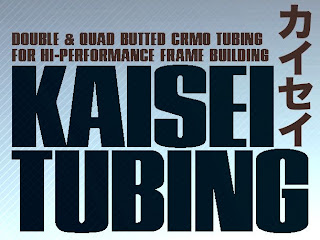I have a fascination with the steels used for frames in the 80s and 90s. Perhaps because that was when I started to ride bikes, but more likely because that’s when I started to learn the secrets of the steels.
For many reasons, quality steel (in the manufacture of lightweight bicycles) became very unpopular by the start of this century. But it was far earlier that some of the key players in the steel tubing industry had closed their doors.
Japanese Ishiwata tubing did not have marketing success that the bigger tubing manufacturers had. However they did produce high quality CrMo tubing, used by custom framebuilders worldwide, many top tier manufacturers, and was tubing choice for the Japanese Keirin. Fuji used Ishiwata tubing in their Keirin frames back in the 80's, and in the very early 90s many Bridgestone frames were made of blends of the Ishiwata tubings.
Ishiwata was easy to work with and could produce a frame that was strong as (and in no way inferior to) Columbus, Reynolds or Tange (see my post on Tange here). The most common Ishiwata was virtually identical to Columbus in specification. Ishiwata 022 tube was 0.9/0.6mm, the same as Columbus SP. It was named "022" because the frame tube set weighed just under 2.2kgs.
The same material drawn thinner to 0.8/0.5mm was called "019" because it weighed 1.9 kgs, the same as Columbus SL. Frame builders and manufacturers mixed gauges so a small frame might be all 019 but a larger one would have 022 chainstays and downtube. This mix increased stiffness whilst minimising additional weight.
The lighter, top of the range tubes (015 and 017) were seamless double butted and the finish quality was reported to be was much higher than Columbus and Reynolds. These tubesets were very specialist, and designed for the track, very small frames, or lightweight riders.
Ishiwata was a seamed tubing, so it was easy to custom specify multiple-level butting on the tubes, as well as tapered butt sections. Quad butted tubes were not uncommon. Ishiwata could roll the flat steel stock to the varying thickness and dimensions required by the customer, bend the flat stock over a mandrel, and weld at the seam to make tubing. Some declare seamed tubing inferior or “cheap”, however in a bicycle application the strength of the seamed tubing is not compromised enough to be an issue.
 In the late '70s, Trek built three racing frames in the USA, one with Ishiwata 019/022, one Reynolds 531 and one Columbus. All three had identical geometry and weight. The prices were different because of the higher “sticker value” of the European tubing, making the Ishiwata frame the best value. Marketing took over later as the Ishiwata frame was dropped completely from the Trek line. With the arrival of aluminium frames, the late 80s currency crash and the Japanese depression, Ishiwata closed the doors.
In the late '70s, Trek built three racing frames in the USA, one with Ishiwata 019/022, one Reynolds 531 and one Columbus. All three had identical geometry and weight. The prices were different because of the higher “sticker value” of the European tubing, making the Ishiwata frame the best value. Marketing took over later as the Ishiwata frame was dropped completely from the Trek line. With the arrival of aluminium frames, the late 80s currency crash and the Japanese depression, Ishiwata closed the doors.Today, Kaisei tubing is a direct descendent of Ishiwata. When Ishiwata closed its doors in 1993, Kaisei became home to many of Ishiwata's most experienced employees and also took over its butted tube manufacturing process. Kaisei currently holds a 60 per cent share of Japan's elite Keirin frame building market.

